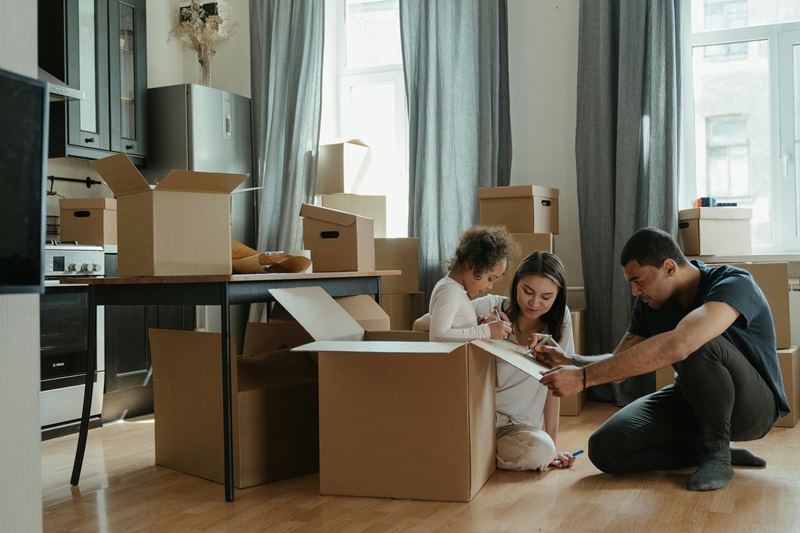How do you pack your entire life into boxes without losing your mind—or your socks?
It’s a question almost everyone faces at some point, whether it’s for a new job, more space, or just the thrill of not sharing a wall with your neighbor’s subwoofer. Moving day arrives like a freight train, and poor planning can leave you flattened. In this blog, we will share efficient packing tips to help you stay sane and organized during your next move.
Why Packing Has Become a Modern-Day Challenge
Packing didn’t used to feel so complicated. In earlier decades, you could toss your things in a few milk crates and load up a truck. Now, moving is more like a military operation—part logistics, part emotional damage control. The average American owns more than 300,000 items. That’s not a typo. It’s a number pulled from the consumer reality we now live in, where even a one-bedroom apartment can feel like an overstocked storage unit.
This cultural shift toward accumulation means packing has to evolve. That’s especially true in cities, where rent is rising, square footage is shrinking, and transient lifestyles are the norm. From frequent job changes to the rise of remote work and digital nomadism, the days of settling down in one place for 30 years are mostly gone. We now move for opportunity, sanity, or simply because our lease is up.
In response, many people are hiring a local moving company to handle not just the heavy lifting, but the planning and packing as well. It’s not laziness. It’s about outsourcing stress. These companies understand the urgency of modern life and have packing strategies tailored for speed, precision, and space-saving efficiency. When you’re juggling work deadlines and apartment walkthroughs, having a crew that knows how to box your kitchen in under an hour can feel less like a luxury and more like a life hack.
The popularity of these companies has grown alongside the rise in short-term rentals, temporary relocations, and hybrid work setups. People need to move quickly and with minimal friction. A moving company offers a way to handle the chaos without letting it derail your week. Their presence in the moving equation reflects the way people now think about time: less as something to save, and more as something not to waste.
Start With Ruthless Sorting, Not Sentiment
Most people start packing by boxing up what they own. That’s backward. The first step should be deciding what not to bring. Unless you want to pay to move a collection of mystery cords, it’s smarter to get brutally honest. If you haven’t worn it, used it, or thought about it in the last year, it’s probably not worth packing.
This is where the rise of minimalism, and the slow rejection of overconsumption, sneaks in. With economic uncertainty and inflation top of mind for many, people are trimming excess. Moving becomes a chance to shed weight—physically and psychologically. You don’t need to become a full-blown minimalist, but the idea that less stuff equals more freedom has traction for a reason.
Sorting before packing also reduces the number of boxes, which matters more than people realize. Every box takes time, tape, space in a truck, and attention on arrival. The fewer boxes you have, the faster and cheaper everything moves. Donate clothes. Recycle the junk drawer. Sell old electronics before they become e-waste. What’s gone now doesn’t have to be unpacked later.
Use the Right Boxes, Not Just Any Boxes
There’s an old myth that all boxes are equal. They’re not. A box from the liquor store may be free, but it’s also probably about to fall apart. When your goal is efficient packing, the quality and uniformity of your containers matter. Use sturdy, same-size boxes for most items. That consistency makes them easier to stack, load, and fit like Tetris in a moving truck.
There’s irony here: people will spend thousands on new apartments but balk at buying boxes. Yet investing in the right supplies—heavy-duty tape, bubble wrap, clean wardrobe boxes—saves more than it costs. It protects your things and helps avoid delays caused by broken or awkward loads.
Try not to overpack large boxes. Books go in smaller boxes. Bedding and clothes can go in bigger ones. Mixing light and heavy items is fine, as long as the final weight stays manageable. Labeling should go on multiple sides, not just the top, because boxes will get turned.
Tackle One Room at a Time—But Don’t Dwell
The kitchen looks innocent until you start packing it. Then it becomes a psychological operation. Mismatched lids. Expired spices. That one drawer full of rubber bands and soy sauce packets. It’s easy to get stuck overthinking where to start. The solution is to go room by room and keep moving. Don’t bounce between spaces or you’ll create confusion and half-packed zones.
Set short deadlines for each area. Two hours for the bathroom. Three for the bedroom. The goal isn’t perfection—it’s progress. Use colored tape or markers for each room to make unloading easier. Keep a few essentials out for the final night and first morning—clothes, chargers, medicine, toiletries. Label this box “Open First” or you’ll end up digging through twelve others to find your toothbrush.
Pack the most-used items last and the least-used first. Seasonal decor, guest bedding, and backup supplies can go early. Everyday dishes, electronics, and your work setup should wait until the final days.
Packing in a Post-COVID World
The pandemic reshaped how and where people live. More folks are working remotely, leaving cities, moving closer to family, or downsizing for financial breathing room. As housing costs rise, many are moving into smaller homes and reevaluating what’s worth keeping.
That shift changed how people pack. Flexibility now matters more than permanence. People want quick setups and faster unpacking. They’re ditching massive entertainment centers and embracing modular furniture. Packing, in that sense, reflects the broader trend: mobility over attachment.
In this context, efficient packing isn’t just about time-saving. It’s a response to instability. When the future feels uncertain, having fewer things—and knowing exactly where they are—gives people more control.
Last Words Before the Tape Gun Closes
There’s no such thing as a perfect move. Something will spill, something will break, and something will get lost. The goal isn’t to avoid chaos. It’s to reduce how much of it shows up. Packing efficiently is the closest thing to a shield you’ll get. It turns moving from a scramble into a plan.
And if that still feels like too much? Hire help. Seriously. Some problems aren’t character-building. They’re just problems. The right supplies, a bit of structure, and some pacing can keep your move on track. You’ll be unpacked faster, calmer, and with most of your sanity—and your socks—intact.




